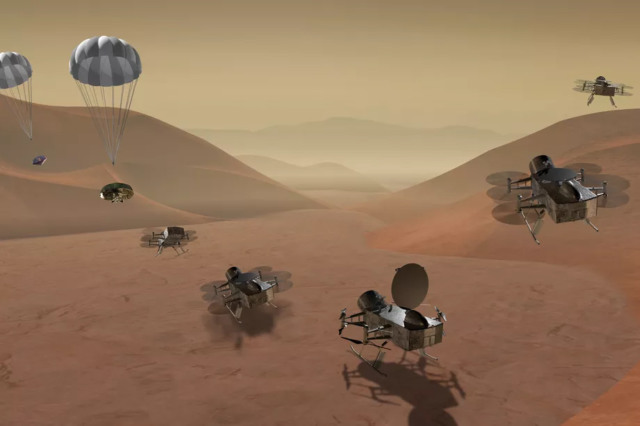NASA chooses Saturn’s moon Titan as its next destination. Gimme a cosmic hell yeah, comrades!

Oh fuck yeah, fellas! NASA is going to Saturn’s moon Titan. It ain’t exactly a settlement on Mars, but, fuck it, I’ll take it.
The Verge:
A new mission involving a drone-like lander will explore the surface of Saturn’s moon Titan. The mission — called Dragonfly — received a coveted funding slot from NASA’s New Frontiers program, which funds ambitious missions to explore objects in our Solar System.
The Dragonfly mission will send a dual-quadcopter the surface of Titan. It will look like a drone, with eight rotors helping it soar across the moon’s surface for tens of miles at a time in under an hour. It will make one of these ‘hops’ about once every 16 days, spending a lot of time sampling the surface, and observing the weather. The mission is being led by Elizabeth Turtle of Johns Hopkins University Applied Physics Laboratory.
Dragonfly was one of two finalists being considered for the New Frontiers award. The other, CAESAR, led by Steve Squyres at Cornell University, and would have aimed to grab a piece of a comet’s surface and bring it back to Earth.
The two missions had already made it through several competitive rounds before the final decision New Frontiers missions generally cost around $850 million to develop, making them slightly pricier than the agency’s Discovery missions, like the Mars InSight lander, which cost about $814 million, or the Dawn spacecraft which cost $500 million.
Only three other missions have been funded through the New Frontiers program. The Juno spacecraft, in orbit around Jupiter, has been observing the giant planet’s roiling atmosphere and magnetic field. New Horizons wooshed by Pluto in 2015, and flew by a Kuiper Belt object in December of 2018. And OSIRIS-REX, an asteroid-sampling mission is currently in orbit around the asteroid Bennu, looking for a safe place to grab a sample next year.
Like those missions, Dragonfly is expected to expand our view of distant objects in the solar system — in this case, Saturn’s moon Titan, whose bizarre chemistry and thick atmosphere have intrigued scientists for years. (It is the only moon in our system to boast a substantial atmosphere.) The Huygens probe, carried by Cassini gave us a first glimpse of the moon’s surface. Then, Cassini itself revealed that Titan had lakes of liquid methane on the surface — making it the only other body in our Solar System to boast liquid besides Earth. Dragonfly’s ability to travel across the surface will let researchers visit several interesting sites over the course of the planned two year mission, potentially traveling hundreds of kilometers during that time.



